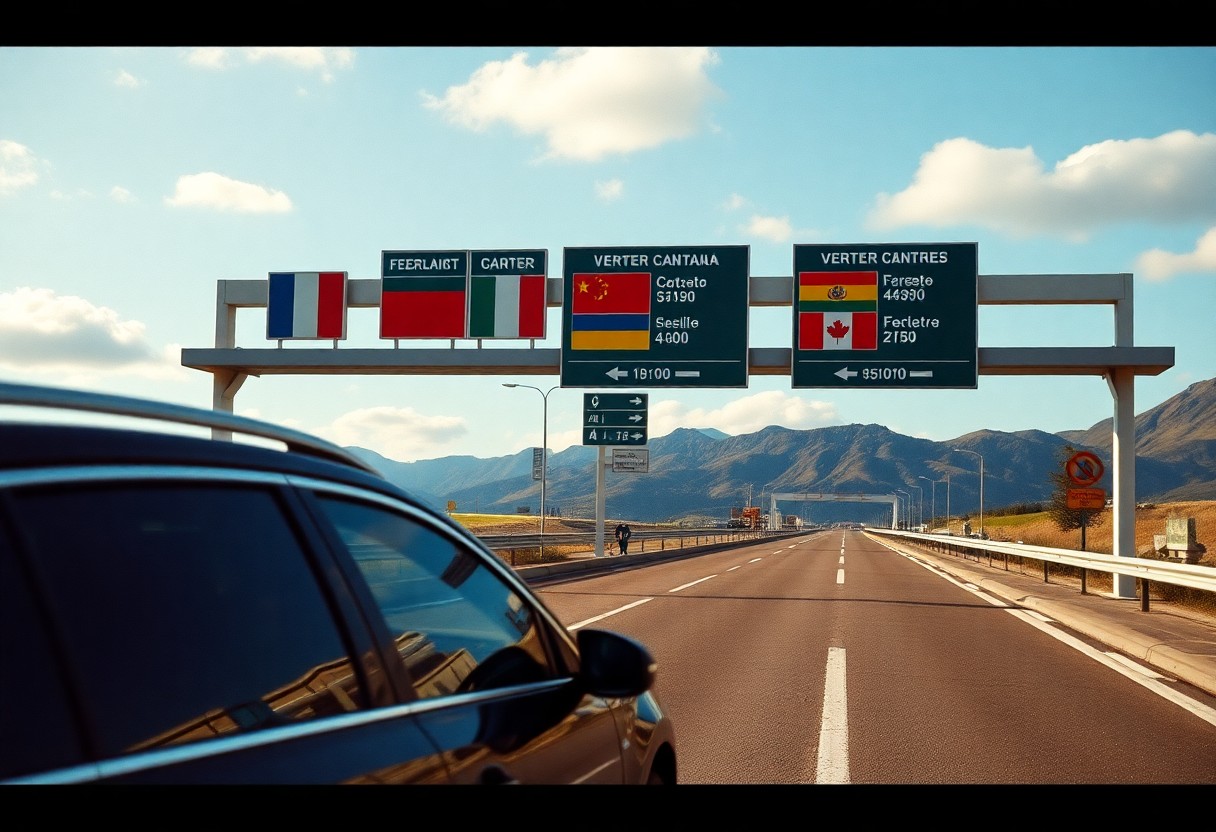Planning your European road trip with a rental car is crucial for an unforgettable adventure. It requires meticulous route planning and a comprehensive understanding of cross-border regulations. Different rental agencies have distinct policies regarding driving between countries in Europe. While most companies permit travel across Western European nations, they often impose restrictions for Eastern European countries. It’s imperative to thoroughly examine your rental agreement, as it will detail the specific borders you are allowed to cross and any additional fees that may apply. Before finalizing your booking, confirm that your selected rental provider allows travel to all your intended destinations; violating these rules could nullify your insurance and lead to hefty penalties. Hence, gathering clear information about these restrictions is essential for a seamless road trip experience.
Understand Legal Requirements for Cross-Border Driving in Europe
Before you hit the road across Europe with your rental car, it is vital to meet specific legal and rental company requirements. Ensure your rental agreement explicitly indicates that cross-border travel is permitted, along with valid insurance coverage for all countries on your itinerary. Many rental agencies impose restrictions based on specific European zones, and these regulations may be more stringent for luxury vehicles. Therefore, familiarizing yourself with these requirements can prevent unexpected complications during your travels, allowing you to focus on enjoying your journey.
Secure Your International Driving Permit (IDP) for Smooth Travel
One of the most essential documents you need for driving in Europe is an International Driving Permit (IDP). It is crucial to obtain this permit in your home country before embarking on your travel plans. The IDP complements your standard driver’s license and is legally required in many European nations. By securing your IDP in advance, you ensure compliance with local regulations, which can facilitate a smoother driving experience across diverse countries, allowing you to enjoy the scenic routes and rich cultural experiences Europe has to offer.
Familiarize Yourself with Mileage Policies and General Restrictions
When you rent a car in Europe, many rental locations provide vehicles with unlimited mileage options, which is a significant benefit for travelers who plan to explore extensively. However, it’s essential to be aware that border crossing fees may apply, which can vary significantly, typically ranging from €5 to €47.60 per crossing, depending on the rental agency and the countries involved. Additionally, due to insurance and security protocols, rental companies often impose specific restrictions for various vehicle categories. For instance, high-end brands like BMW, Mercedes, and Audi may face more stringent travel limitations compared to standard models, emphasizing the importance of declaring your travel intentions in advance to avoid unexpected costs.

Explore Cross-Border Policies of Leading Rental Companies
When renting a car in Europe, it’s essential to recognize that each rental company has unique cross-border policies. Major rental agencies typically allow travel between Western European countries, but you’ll find that strict restrictions apply for Eastern Europe. These policies can differ significantly based on the type of vehicle, with luxury cars often facing more limitations compared to standard vehicles. Gaining a clear understanding of these policies ahead of time will empower you to make informed decisions regarding your rental choices and travel itinerary.
Cross-Border Regulations for Avis and Enterprise Rentals
Avis and Enterprise are two rental companies that provide extensive coverage across Western Europe. Their vehicles are generally permitted to travel in most EU countries, including popular destinations like France, Germany, and Spain. However, it’s crucial to note that both companies impose specific restrictions on luxury vehicles, particularly when entering Italy. For example, Enterprise applies a daily cross-border fee of 5 euros, capping at a maximum total charge of 50 euros. Familiarizing yourself with these fees and policies will enable you to budget effectively for your travels and avoid unpleasant surprises.
Cross-Border Travel Regulations from AutoEurope and Hertz
Among the prominent rental providers, AutoEurope and Hertz enforce defined country restrictions that travelers need to understand. For instance, taking their vehicles into Eastern European nations such as Albania, Belarus, or Ukraine is strictly prohibited. Additionally, Hertz restricts luxury vehicles and SUVs from entering Italy, while AutoEurope’s policies may vary based on their local partners. Therefore, it is vital to declare your travel plans to your chosen rental provider before confirming your booking. Your rental agreement will specify the cross-border fees applicable, which differ by company and destination. For example, Hertz may charge 47.60 euros for crossing from Germany to another approved country, and you will likely need additional insurance coverage for international travel.
Be Aware of Geographical Restrictions on Your Travel
The regulations governing cross-border travel with rental cars in Europe can vary widely depending on the rental company and the type of vehicle you select. Your rental agreement will clearly outline which countries you are allowed to visit with your rental vehicle. It’s essential to keep your rental provider informed of your planned route, as crossing borders without proper authorization can void your insurance and lead to significant penalties, potentially disrupting your travel experience.
Countries You Can Drive Your Rental Car In
Most rental companies generally allow you to drive freely within Western European countries, including France, Germany, and Spain. Zone 1 countries typically include EU member states in Western Europe, providing the most flexibility for your rental car usage. Your rental agreement will detail all the permitted countries specific to your vehicle class, ensuring that you have a clear understanding of where you can travel and preventing unintentional rule violations.
Avoiding Restricted Territories During Your Travels
Countries that were once behind the Iron Curtain often come with restrictions. Most rental companies prohibit travel to Eastern European nations, such as Albania, Belarus, Ukraine, and Russia, due to elevated risks and complications with insurance coverage. Additionally, more limitations may apply to luxury vehicles and specific car brands. High-end vehicles like BMW, Mercedes, and other premium models often face stricter geographical limitations. If your travel plans involve visiting multiple countries, it is advisable to opt for a standard vehicle class to maximize flexibility and minimize potential fees or insurance issues.
Recognize Vehicle-Specific Limitations for Your Rental Car
While rental agencies may have varying policies, most enforce strict regulations regarding which vehicles can cross borders. Therefore, it is essential to check the specific limitations associated with your selected vehicle class before making a booking. These restrictions are in place to safeguard valuable assets and ensure compliance with insurance requirements across different European territories, providing peace of mind during your travels.
Enjoy Flexibility with Standard Rental Cars
Contrary to common misconceptions, standard rental cars offer the greatest flexibility for cross-border travel. You can usually drive standard vehicles in most Western European countries without needing special permits. However, ensure you inform your rental company about your travel intentions and be prepared to pay cross-border fees that may range from 5 to 50 euros depending on the situation, ensuring no surprises arise during your journey.
Understand Restrictions on Luxury Vehicles for Cross-Border Travel
Significant restrictions are applicable to high-end vehicles when it comes to cross-border travel. Luxury cars face considerable limitations on border crossings, with brands such as BMW, Mercedes, and Audi often restricted from entering Eastern European countries or Italy. Generally, these luxury vehicles are restricted to Zone 1 countries within Western Europe, which can affect your travel plans significantly.
Furthermore, if you intend to rent luxury vehicles, anticipate higher security deposits and stricter insurance requirements. Rental companies like Sixt and Enterprise impose limitations on premium brands such as Jaguar, Maserati, and Porsche, permitting them only in select Western European countries. For any border crossings, you will need special authorization and possibly additional insurance coverage to ensure compliance with regulations.
Plan Your Budget for Border Crossing Costs
It’s crucial to keep your budget in mind when planning any cross-border trips in Europe with a rental car. Most rental companies impose additional fees for crossing borders, even within the Schengen Area. It’s essential to inform your rental company about your intended route and obtain written permission prior to crossing any borders to avoid unexpected charges that could affect your travel budget.
Common Fees Associated with Border Crossings
Border crossing fees in Europe typically range from €5 to €50, contingent upon the rental company and specific circumstances. For instance, you’ll incur €47.60 with Hertz when crossing from Germany to another allowed country, while Enterprise charges €5 per day, capping at €50 for trips originating in Germany. Being fully aware of these fees will assist you in planning your finances effectively during your travels, ensuring a smoother experience.
Consider Potential Additional Charges
At certain borders, you may encounter extra insurance requirements and documentation fees that could impact your budget. Your rental company might impose charges for special permits, especially when traveling to Eastern European countries or when renting luxury vehicles. Additionally, consider the possibility of higher insurance premiums for specific destinations, particularly in Italy or Eastern Europe. Keep in mind that some credit card insurance policies may not cover all European countries, making it necessary to purchase additional coverage from your rental agency for complete peace of mind while traveling.

Mastering Ferry Travel with Your Rental Car
Not all rental companies maintain the same policies regarding ferry travel in Europe. While most agencies allow ferry travel, it’s crucial to verify the specific stipulations associated with your rental. Crossing water borders often necessitates additional documentation and may incur extra fees, so be prepared to understand these aspects thoroughly. Additionally, your insurance coverage may change when traveling by ferry, making it essential to clarify these details with your rental provider.
Understanding Company-Specific Policies for Ferry Travel
Among leading rental companies, policies regarding ferry travel can differ significantly. Avis and Hertz typically allow ferry travel to approved countries, but it’s essential to verify destination restrictions beforehand to prevent complications. Simultaneously, Enterprise and Sixt may require pre-authorization and additional insurance for ferry crossings, which must be explicitly stated in your rental agreement to avoid misunderstandings that could disrupt your travel plans.
Key Considerations for Breakdown Coverage During Ferry Travel
Another vital factor to consider is vehicle breakdown coverage in case of ferry travel. Most rental companies hold you accountable for vehicle repatriation costs if your car breaks down after a ferry crossing, which can amount to thousands of euros, depending on your location and the type of vehicle rented. This responsibility extends beyond mechanical failures; if you have an accident or the vehicle becomes unusable for any reason while on an island, you are liable for the costs required to return the vehicle to the original rental location. Some rental companies do offer additional insurance to cover these expenses, but it is crucial to purchase it before your journey to ensure your protection against unforeseen circumstances.
Key Insights for Cross-Border Driving with Rental Cars
When planning to drive a rental car across European borders, extensive research and a clear understanding of your rental company’s specific rules are essential. While you may have the freedom to cross borders in most European nations, remember that each agency has its own policies and fees that you must be aware of. The type of rental vehicle you choose can significantly impact where you are allowed to travel, with luxury cars often facing more restrictions than standard models. Always confirm the countries you are permitted to visit, account for any required border crossing fees, and review ferry travel regulations before starting your journey. Diligently reading the rental agreement and obtaining an International Driving Permit will further prepare you for a hassle-free travel experience. Your proactive planning is key to avoiding complications at border crossings, ensuring a more enjoyable and memorable adventure.
Your Questions Answered: Driving Rental Cars in Europe
Can I drive my rental car to any European country?
No, rental companies have specific regulations regarding the countries you may visit. Most agencies permit travel within Western European nations such as France, Germany, and Spain. However, many impose restrictions on travel to Eastern European countries, including Albania, Belarus, and Ukraine. Luxury vehicles often come with stricter limitations. Always check your rental agreement for the allowed countries prior to any border crossings to avoid complications.
Will I face additional fees for crossing borders with a rental car in Europe?
Yes, numerous rental companies impose border crossing fees. For example, Hertz charges 47.60 euros for each border crossing from Germany, while Enterprise charges 5 euros per day (with a maximum of 50 euros) for trips originating in Germany. These fees apply even when traveling within the Schengen Area. It is crucial to inform the rental company about your travel itinerary and settle these fees before crossing any borders to avoid unexpected expenses.
Can I take my rental car on a ferry between European countries?
Yes, most rental companies allow ferry travel if your destination country is included on their approved list. However, if your vehicle breaks down while on an island, you will be responsible for the costs associated with returning the vehicle to its initial rental location. Some companies, like Hertz, offer coverage for ferry travel through their insurance options (CDW, TP, or SuperCover). Always verify the specific ferry policies stated in your rental agreement to avoid any surprises during your journey.
The Article: Is It Allowed to Drive a Rental Car Across European Borders? appeared first on https://rentacar24.org/
The Article Driving a Rental Car Across European Borders: Is It Allowed? Was Found On https://limitsofstrategy.com

Comments
4 responses to “Driving a Rental Car Across Borders in Europe: Guidelines”
This topic on planning a European road trip resonates deeply with me, as I’ve always viewed road travel as more than just a means to get from one destination to another; it’s about the journey and the experiences that unfold along the way. I remember a particularly memorable trip across the Italian countryside where I spent hours lost amidst vineyards and charming villages. Throughout that journey, I often found myself reflecting on the ease of driving with a rental vehicle. However, your insights regarding cross-border regulations and rental policies highlight an essential aspect of traveling that often gets overlooked in the excitement of planning.
Your insights on planning a European road trip with a rental car really resonate with me, especially when considering the thrill of exploring diverse landscapes and cultures. I remember my own adventure driving through Europe a couple of years ago, and I wish I had come across this advice beforehand!
It’s great to hear that my insights struck a chord with you. The excitement of a European road trip really does hinge on the diverse landscapes and cultures you encounter along the way. It’s a unique experience that allows you to immerse yourself in the local lifestyle, connecting with people and discovering hidden gems that you might miss when traveling by train or plane.
Your insights on planning a European road trip really highlight the often-overlooked complexities of cross-border travel. I’ve learned this the hard way during my last trip when I assumed I could drive freely between EU countries. It turned out I had to navigate through intricate rental policies, which changed my plans at the last minute.